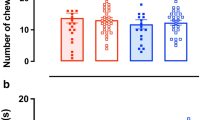Abstract
Prenatal administration of high doses of tricyclic antidepressants have been reported to produce teratogenic and behavioral effects in rat offspring. In the present work, behavioral abnormalities are described in offspring of rats treated with therapeutic doses of chlorimipramine (CIM) during pregnancy (CIM-P), lactation (CIM-L) and during the whole pregnancy-lactation period (CIM-PL). CIM-P treatment did not produce teratogenic effects, did not affect number or body weight of pups at birth and did not induce neonatal mortality. At 2 months of age, the CIM-P males showed a significant increase in digging and grooming (familiar environment test), a decrease in “exploration” (novel environment test) and a decrease in active social interactions (social behavior test). Females were more resistant than males to the prenatal CIM treatment. The results suggest increased emotionality in CIM-P pups. Some behavioral abnormalities were also observed in the tests performed at 4 months of age. CIM-L treatment had minor effects on litter behavior. CIM-PL treatment potentiated the effects of the CIM-P treatment. In the CIM-PL males, impairment of exploration of a novel environment still remained in the tests performed at 4 months of age. It is speculated that when prenatal brain development is altered by CIM, further postnatal treatment may impair compensatory processes occurring in early postnatal life.
Similar content being viewed by others
References
Avery DD, Moss DE, Hendrick SA (1976) Food deprivation at weaning and adult behavior elicited by hypothalamic stimulation in the rat. Behav Biol 16:155–160
Bickel MH, Weder HJ (1968) The total fate of a drug: Kinetics of distribution, excretion and formation of 14 metabolites in rats treated with imipramine. Arch Int Pharmacodyn Ther 173:433–463
Broitman ST, Donoso AO (1974) Maternal and sex-related influences on locomotor activity in rats. Physiol Behav 12:309–312
Broitman ST, Donoso AO (1978) Effects of chronic imipramine and clomipramine oral administration on maternal behavior and litter development. Psychopharmacology 56:93–101
Carlsson A, Corrodi H, Fuxe K, Hökfelt T (1969) Effect of antidepressant drugs on the depletion of intraneuronal brain 5-hydroxytryptamine stores caused by 4-methyl-α-ethyl-meta-tyramine. Eur J Pharmacol 5:357–366
Colbern D, Isaacson RL, Green EJ, Gispen WH (1978) Repeated intraventricular injections of ACTH 1–24: The effects of home or novel environments on excessive grooming. Behav Biol 23:381–387
Coyle IR (1975) Changes in developing behavior following prenatal administration of imipramine. Pharmacol Biochem Behav 3:799–807
Crammer JL, Scott B, Woods H, Rolfe B (1968) Metabolism of 14C-imipramine. I. Excretion in the rat and man. Psychopharmacologia 12:263–277
Dunn AJ, Green EJ, Isaacson RL (1979) Intracerebral adrenocorticotropic hormone mediates novelty-induced grooming in the rat. Science 203:281–283
File SE, Hyde JRG (1979a) A test of anxiety that distinguishes between the actions of benzodiazepines and those of other minor tranquilizers and stimulants. Pharmacol Biochem Behav 11:65–69
File SE, Hyde JRG (1979b) Evidence that piracetam has an anxiolytic action. J Affect Disorders 1:227–235
Fleming AS, Vaccarino F, Luebke C (1980) Amygdaloid inhibition of maternal behavior in the multiparous female rat. Physiol Pharmacol 25:731–743
Furgiuele AR, Aument MH, Horovitz ZP (1964) Acute and chronic effects of imipramine and desipramine in normal rats and in rats with lesioned amygdalae. Arch Int Pharmacodyn Ther 151:170–179
Goodman LS, Gilman A (1980) The pharmacological basis of therapeutics. Mac Millan, New York
Gray JA (1971) Sex differences in emotional behavior in mammals including man: Endocrine bases. Acta Psychologica 35:29–46
Green EJ, Isaacson RL, Dunn AJ, Lanthorn TH (1979) Naloxone and haloperidol reduce grooming occurring as an after effect of novelty. Behav Neural Biol 27:546–551
Guran MS, Gill TS, Geber WF (1980) Teratogenicity of imipramine and amitriptyline in fetal hamsters. Psychol Psychiatry Behav 5:275–282
Harper KH, Palmer AK, Davies RE (1965) Effects of imipramine upon the pregnancy of laboratory animals. Arzneimittel-Forsch 15:1218–1221
Herr F, Stewart J, Gjarest MP (1961) Tranquilizers and antidepressants: A pharmacological comparison. Arch Int Pharmacodyn Ther 134:328–342
Horovitz ZP, Furgiuele AR, High JP, Burke JC (1964) Comparative activities of substituted dibenzothiazepine of imipramine and of desipramine. Arch Int Pharmacodyn Ther 151:180–191
Hunt HF, Otis LS (1963) Early experience and its effects on later behavioral processes in rats: I. Initial experiments. Transactions NY Acad Sci 25:858–870
Leonard BE, Kafoe WF (1976) A comparison of the acute and chronic effects of four antidepressant drugs on the turnover of serotonin, dopamine and noradrenaline in the rat brain. Biochem Pharmacol 25:1939–1942
Mirmiran M, Van de Poll NE, Corner MA, Van Oyen HG, Bour HL (1981) Suppression of active sleep by chronic treatment with chlorimipramine during early postnatal development: effects upon adult sleep and behavior in the rat. Brain Res 204:129–146
Ögren SO, Fuxe K, Agnati LF, Gustafsson JA, Jonsson G, Holm AC (1979) Reevaluation of the indolamine hypothesis of depression. Evidence for a reduction of functional activity of central 5-HT systems by antidepressant drug. J Neural Transm 46:83–103
Russell PA (1977) Sex differences in rats stationary exploration as a function of stimulus and environmental novelty. Anim Learn Behav 3:297–302
Singer G (1973) The effect of imipramine administered before and during, pregnancy on litter size in the rat. Psychopharmacologia 32:337–342
Stenger EG, Aeppli I, Fratta I (1965) Teratogenic effects of N-(dimethyl aminoprop. 1) iminodibenzyl-HC (Tofranil) in animals. Arzneim Forsch 15:1222–1224
Watson PI, Short MA, Monroe DH, Warfield DR (1980) Digging and biting induced by pinch stimuli and lateral hypothalamic electrical stimulation. Physiol Behav 24:267–271
Zabic JE, Levine RM, Spauling JH, Maickel RP (1977) Interactions of tricyclic antidepressant drugs with deprivation-induced fluid consumption by rats. Neuropharmacology 16:267–271
Zemp J, Middaugh (1975) Some effects of prenatal exposure to d-amphetamine sulfate and phenobarbital on developmental neurochemistry and on behavior. Addict Dis 2:307–331
Author information
Authors and Affiliations
Rights and permissions
About this article
Cite this article
Rodríguez Echandía, E.L., Broitman, S.T. Effect of prenatal and postnatal exposure to therapeutic doses of chlorimipramine on emotionality in the rat. Psychopharmacology 79, 236–241 (1983). https://doi.org/10.1007/BF00427819
Received:
Accepted:
Issue Date:
DOI: https://doi.org/10.1007/BF00427819




